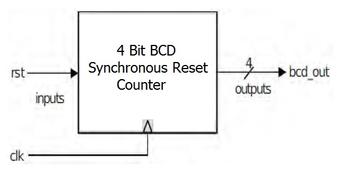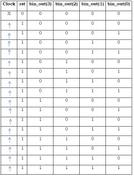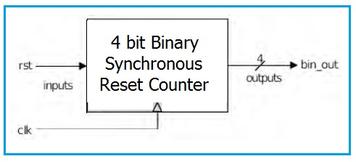4-Bit Down Counter Verilog Code and Test Bench
Advertisement
This document provides Verilog code for a 4-bit down counter and its corresponding test bench.
4-Bit Down Counter Verilog Code
Here’s the Verilog code for a 4-bit down counter.
`define TICK #2
module downCntr(clk, reset, Q);
input clk, reset;
output [3:0] Q;
reg [3:0] Q;
// Behavioral Code for a Down Counter
always @ (posedge clk)
begin
if (~reset)
begin
Q <= Q-1;
end
end
always @ (posedge reset)
begin
Q <= 4'b0000;
end
endmodule
Explanation:
-
“define TICK #2
: This line defines a macro namedTICK`, which is used to represent a time delay (in this case, 2 time units). This is useful for controlling simulation timing. -
module downCntr(clk, reset, Q);: This declares a module nameddownCntrwith inputsclk(clock) andreset, and an outputQ(the 4-bit counter value). -
input clk, reset;: Declaresclkandresetas inputs. -
output [3:0] Q;: DeclaresQas a 4-bit output. -
reg [3:0] Q;: DeclaresQas a 4-bit register, as it will be assigned a value within thealwaysblock. -
always @ (posedge clk): This block is triggered on the positive edge of the clock. -
if (~reset): Checks if the reset signal is low (active low reset). -
Q <= Q-1;: If the reset is not asserted, the counter decrements its value by 1 on each clock cycle. -
always @ (posedge reset): This block is triggered on the positive edge of the reset signal. -
Q <= 4'b0000;: When the reset signal is asserted (high), the counter is reset to 0.
4-Bit Down Counter Test Bench Code
The following Verilog code provides the test bench for the 4-bit down counter.
module main;
reg clk, reset;
wire [3:0] Q;
downCntr dnCntr1(clk, reset, Q);
initial
begin
forever
begin
clk <= 0; #5 clk <= 1; #5 clk <= 0;
end
end
initial
begin
reset = 1; #12 reset = 0; #170 reset = 1; #12 reset = 0;
end
endmodule
Explanation:
-
module main;: Defines the test bench module namedmain. -
reg clk, reset;: Declaresclkandresetas registers, as they will be driven by the test bench. -
wire [3:0] Q;: DeclaresQas a wire, connecting it to the output of thedownCntrmodule. -
downCntr dnCntr1(clk, reset, Q);: Instantiates thedownCntrmodule, connecting its inputs and outputs. -
initial begin ... end: These blocks define the initial behavior of the clock and reset signals. -
The first
initialblock generates a clock signal with a period of 10 time units (5 for low and 5 for high). -
The second
initialblock applies a reset signal. It starts asserted, de-asserts after 12 time units, re-asserts after 170 time units, and de-asserts again after another 12 time units. This allows you to observe the counter’s behavior with and without reset conditions.
Advertisement
 RF
RF






